|

Today’s Weather in Central Malawi from Yahoo
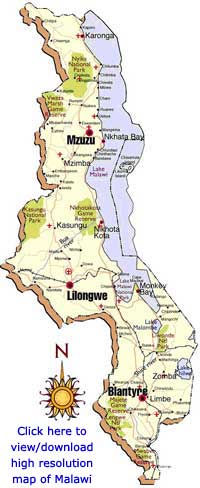 Official Name: Republic of Malawi Official Name: Republic of Malawi
Location: Malawi is located in Southern Africa bordered by Mozambique (East, South & West) Tanzania (North) and Zambia (Northwest).
Size: Malawi covers a geographical area of 118,480 km, which is roughly half the size of the Indian State of Uttar Pradesh (at 238,566 sq km). The country is divided into three regions namely the southern, central and northern region with a total of 28 districts.
Population: Malawi's population estimate as of 2008 is 13.9 million.
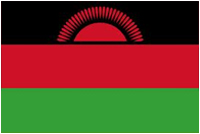 National Flag: The rising sun signifies the dawn of freedom; the black stands for the People of Africa; the red signifies the Blood of the Martyrs of African freedom and the green represents the evergreen nature of Malawi. National Flag: The rising sun signifies the dawn of freedom; the black stands for the People of Africa; the red signifies the Blood of the Martyrs of African freedom and the green represents the evergreen nature of Malawi.
 Coat Of Arms: The national crest has the Rising Sun representing the Dawn of Freedom in Africa, at the top and bottom of the shield. The Fish Eagle and the wavy blue and white bands on the shield symbolize Lake Malawi. The Lion and the Leopard support and guard the crest as a whole. The land at the base is the rugged Mount Mulanje. The Coat of Arms bears the motto Unity and Freedom. Coat Of Arms: The national crest has the Rising Sun representing the Dawn of Freedom in Africa, at the top and bottom of the shield. The Fish Eagle and the wavy blue and white bands on the shield symbolize Lake Malawi. The Lion and the Leopard support and guard the crest as a whole. The land at the base is the rugged Mount Mulanje. The Coat of Arms bears the motto Unity and Freedom.
Major Cities: Lilongwe (the Capital City) and
Blantyre (the Commercial
Capital),
Mzuzu
Climate: Malawi lies within an inter-tropical zone. The country experiences three seasons; cool and dry from May to August; hot and dry from September to mid-November; and hot and wet from November to April.
PEOPLE
 Malawi is often referred to as the "Warm Heart of Africa," due to the warmth and friendliness of the people. Malawians typically live with their extended families in dwellings that are grouped together in villages. A spirit of cooperation prevails as family members share both work and resources. The Malawi people are of Bantu origin with the ethnic (African) groups including: Chewa, Nyanja, Yao, Tumbuka, Lomwe, Sena, Tonga, Ngoni and Ngonde. Malawi is often referred to as the "Warm Heart of Africa," due to the warmth and friendliness of the people. Malawians typically live with their extended families in dwellings that are grouped together in villages. A spirit of cooperation prevails as family members share both work and resources. The Malawi people are of Bantu origin with the ethnic (African) groups including: Chewa, Nyanja, Yao, Tumbuka, Lomwe, Sena, Tonga, Ngoni and Ngonde.
The Chewa people form the largest part of the population group and are largely concentrated in the central and southern parts of the country. The Yao people are predominately found around the southern area of Lake Malawi. The Tumbuka are found mainly in the north of the country. There are small populations of Asian and European people that mostly live in the cities.
CULTURE
 |
Malawi prides itself on a mosaic of unique cultural practices and norms. The main traditional dances and rituals, as well as arts and crafts, found among the people act as an identifying factor for the many, but united ethnic groups of the country. The dances of Malawi, for instance, have deeper meaning than what appears on the surface and, accordingly, effort has been made to keep these intact as part of Malawi's cultural heritage and for posterity.
As a way of achieving the goal of retaining the country's traditional values, the
Museum of Malawi conducts a series of cultural activities in schools and public places so that those who do not have contact with village life can benefit from facilities offered by the organization.
Also see the website of the Warehouse Cultural Centre.
|
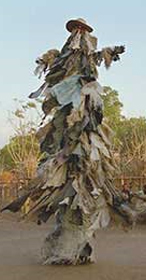 |
Languages: English is the official language and is very widely spoken, particularly in main towns, but sometimes also in remote rural areas. Chichewa, is the common national tongue widely used throughout the country.
Religions: The Chewa people, who form the largest part of the population, are predominantly Christian/Protestant and the Yao people are mainly Muslim. The religious groups in Malawi can be broken down approximately as follows: Christianity 75% (Protestant 55% and Roman Catholic 20%); Islam 20%; and 5% for those of traditional indigenous beliefs and other minor religions.
HISTORY OF MALAWI
The first inhabitants
of Malawi are thought to have started
settling around Lake Malawi about
10,000BC. During the 16th century there
was a vast trading empire established by
the Maravi people from whom the country
derives its modern name. The first
European to make contact with the area
now known as Malawi may have been the
Portuguese explorer Gaspar Bocarro,
whose diary published in 1492 made
reference to the great inland lake in
central Africa. The slave trade which
ravaged most of Africa from 16th Century
to the 19th Century also left its
imprints on Malawi’s historical
development. The Arab slave traders
arrived on the shores of Lake Malawi
from Zanzibar Island in the Indian Ocean
in search of slaves sometime after 1840
and continued until 19th Century.
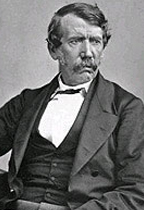 The
history of modern Malawi is linked with
the life of the Scottish missionary
explorer,
David Livingstone (1813 to
1873) who reached the lake he named
‘Lake Nyasa’ in 1859. Following his
appeal to other missionaries to come and
fight the slave trade in Central and
East Africa, the first missionary
expedition of the Universities Mission
to Central Africa (UMCA) arrived in
Malawi in 1861. However, it was not
until 1875 that the first permanent
mission station was established at Cape
Maclear on Lake Malawi by the Free
Church of Scotland. The
history of modern Malawi is linked with
the life of the Scottish missionary
explorer,
David Livingstone (1813 to
1873) who reached the lake he named
‘Lake Nyasa’ in 1859. Following his
appeal to other missionaries to come and
fight the slave trade in Central and
East Africa, the first missionary
expedition of the Universities Mission
to Central Africa (UMCA) arrived in
Malawi in 1861. However, it was not
until 1875 that the first permanent
mission station was established at Cape
Maclear on Lake Malawi by the Free
Church of Scotland.
In 1876, Blantyre
Mission was established. This is one of
the main seats of what is now known as
the Church of Central Africa
Presbyterian (CCAP). In 1884, the first
European trading station was established
in Karonga, Malawi’s northeast point.
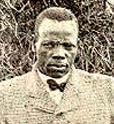 In
1891, the British Government declared a
Protectorate over what was then known as
Nyasaland Districts. This was later
changed, in 1893, to the British Central
Africa Protectorate and later Nyasaland
Protectorate in 1907. The political
struggle against British rule in
Nyasaland, where the Africans were
subjected to many unfair practices,
reached its peak with the uprising in
1915 led by
John Chilembwe who is
considered the father of Malawi’s
nationalism and hailed from Chiradzulu
district. In
1891, the British Government declared a
Protectorate over what was then known as
Nyasaland Districts. This was later
changed, in 1893, to the British Central
Africa Protectorate and later Nyasaland
Protectorate in 1907. The political
struggle against British rule in
Nyasaland, where the Africans were
subjected to many unfair practices,
reached its peak with the uprising in
1915 led by
John Chilembwe who is
considered the father of Malawi’s
nationalism and hailed from Chiradzulu
district.
 Although the uprising was not
successful, the Africans’ dislike of the
British rule continued and, in 1944, the
Nyasaland African Congress—later changed
to Malawi Congress Party under the
leadership of
Dr. Hastings Kamuzu Banda
in 1959—was formed to mobilize the
people to fight for their rights and
ultimately achieve independence from
Britain.
Although the uprising was not
successful, the Africans’ dislike of the
British rule continued and, in 1944, the
Nyasaland African Congress—later changed
to Malawi Congress Party under the
leadership of
Dr. Hastings Kamuzu Banda
in 1959—was formed to mobilize the
people to fight for their rights and
ultimately achieve independence from
Britain.
In 1953, the
Federation of Rhodesia and Nyasaland was
formed despite African opposition. This
meant that the British Government had
virtually transferred its protectorate
responsibility over Nyasaland to the
white settlers of Southern Rhodesia. But
the African resistance to the
federation, forced the British to shelve
the idea. Constitutional talks for
Malawi’s independence were later held at
Lancaster House in London in July 1960
after which Nyasaland was allowed a
Legislative Council. Nyasaland became an
independent state of Malawi on July 6,
1964. Two years later, the country
became a Republic, with Dr. Hastings
Kamuzu Banda as the first President.
This was also the year that Malawi
became, by act of Parliament, a one
party state.
After three decades
of one-party rule under President
Hastings Kamuzu Banda, the country held
multiparty elections in 1994, under a
provisional constitution, which came
into full effect the following year.
The first elections
under the multiparty system took place
on 17 May 1994, where by Dr. Bakili
Muluzi was elected into office as the
country’s first democratic president, he
was re-elected in 1999. In 2004, Malawi
held its third multi-party elections and
elected President Dr. Bingu wa Mutharika
as the Head of State. |